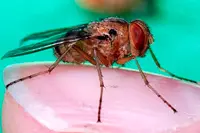 Staff at the University of Strathclyde have used the way a fly hears to develop what is claimed to be a revolutionary hearing aid design involving multi-directional microphone technology.
Staff at the University of Strathclyde have used the way a fly hears to develop what is claimed to be a revolutionary hearing aid design involving multi-directional microphone technology.
Staff at the University of Strathclyde have used the way a fly hears to develop what is claimed to be a revolutionary hearing aid design involving multi-directional microphone technology.
The Ormia ochracea fly, pictured, has a structure in the 2mm gap between its ears that pivots when a sound passes through it so the insect can ascertain the direction from which the sound originated.
Though advances in hearing aid design and sound analysis have advanced over the years, the microphone technology that is used has barely changed in decades.
Dr James Windmill, of the Centre for Ultrasonic Engineering at Strathclyde, said: "Currently, users can tell whether a sound source is in front or behind, but struggle to detect sounds from below or above, such as echoes in a large room.
"We aim to solve the problem using a new type of miniature directional microphone, inspired by how some insects hear sounds."
Up to 10million people in the UK are affected by hearing loss, but only 20% of these actually use hearing aids. One of the reasons for this is that hearing aids offer poor sound quality and poor performance in noisy environments.
Dr Windmill is confident the new technology will be able to effectively combat this existing design problem. "We will be able to evaluate the problems caused by the distance from which a sound emanates, for example how to separate a sound from a loud source far away, like a train or plane, from a quiet sound from nearby, like a human voice.
"The project will also investigate 3D printing techniques to optimise the hearing aid design so that it works best acoustically in conjunction with the new microphone."
Strathclyde will design, build and test the new microphones and hearing aid structures. Meanwhile, the Institute for Hearing Research at the Glasgow Royal Infirmary will test their operation, including human trials of the new designs.
Author
Tom Austin-Morgan
Source: www.newelectronics.co.uk

